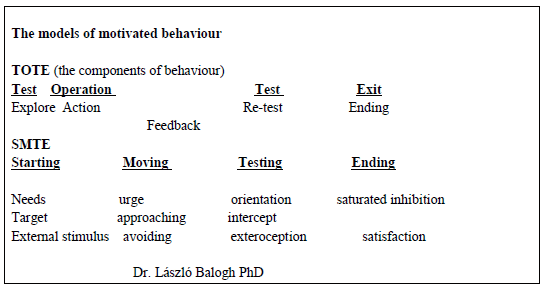Why should we start? Motivation
Throughout our life our actions are rooted in impulses, aims and goals, even if we are not aware of this.
Looking at this thesis this explanation seems quite simple and evident from the aspects of psycho-physiology1. Our organism pursues to maintain the homeostatic balance. If deficiency occurs such as hunger, thirst or some high-order needs we try to decrease this deficiency by recognition, knowledge and self-realization2. When getting the feedback that the deficiency has been abolished then the necessity of motivated activity will cease. This diagram shows the two theories.

Figure 3.These data are based on the work of Miller, Galanter, Plibram (1960) entitled The physiological basics of motivated behaviour.
An English coach working for a Hungarian first-class football team was surprised to experience that his players were complaining about lack of motivation. He could not understand this complaint as in the sports culture he had been brought up it is out of the question to motivate professional, sure-footed, purposeful athletes. Self motivation is evident. They are educated in such an educational atmosphere where learners are equipped with skills and competences enabling them to practice self motivation later in their career. Thus junior education in this culture trains and teaches athletes to become aware of how to achieve higher performance in their future career.
PE teachers often experience that their students are reluctant to change and participate actively in their classes. The question arises here, what the reason can be for refusing physical activities or starting doing some sports?
One of the theories divides motivation into two parts, that is performance and motivation to participate.
Weinberg and Gould (2011) emphasize that there is a difference between finding the reason for somebody’s willingness to do sports or his/her pursue and intention to achieve higher performance. If we talk about only participation it involves good company, pleasure, relaxation, sense of achievement, and maintaining general fitness (Nagykáldi, 1998). Considering all these facts our students will start doing sports if all the above mentioned factors are present in our education.
In Gill’s (1986, in Nagykáldi, 1998 p. 58) view “motivating the achievement of higher performance is a personal orientation within which athletes pursue success, yet they will persist even after failures”. In other words drive3 overlaid on motivation refers to achieve high performance. Here the notion of demand level should also be looked at. This means the athlete’s personal demand to perform. It is known that if the success-oriented athlete has realistic challenges it raises his/her demand level. Whereas a failure-oriented competitor’s demand level, that sets either weaker or more difficult objectives, will not change significantly.
The model of achievement motivation was written by Atkinson, Feather (1996). It deals with both personal and situational factors, see diagram 4.

Figure 4. Theory of interaction aiming to achieve goals and aims
The first factor refers to the achievement oriented athlete who pursues success while the one who keeps avoiding failure naturally does not want any failure. The second factor refers to the competitor who is better motivated in difficult situations. The characteristic feature of the third behaviour pursues challenges while the lower achievement-oriented athletes mainly focus on avoiding failure. The forth, the emotional factor, motivates both athlete types, but the successful athletes focus on pride, in contrast to the less efficient athletes whose focus is on shame. There is also a big difference between risk taking of high and low achievers. The former ones undertake challenges and risks.
Deci (see Cashmore, 2008, 165, 242) differentiates between intrinsic and extrinsic motivations. These notions explain well that the intrinsically motivated athlete wants to achieve his/her goals that make him/her happy. The extrinsically motivated sportsmen/sportswomen do sports, for example, for money. It is a problem especially in case of junior athletes because as soon as they are rewarded either wrongly or deserved they will be interested in benefits and not in the enjoyment of achieving success. Naturally it is not a problem if an athlete wants to earn money but it is a problem if it becomes his/her primary aim. When athletes fail and no benefits are offered then they will easily give up doing sports.
Herzberg’stheory4 explains that pure financial motivation will not result in higher achievement. It is a cliché that little money goes with poor football while lots of money results in excellent football.
[1] Check more details of Hull’s drive theory regarding stress.
[2] No details of Maslow hierarchy are needed here. Details can be read on this website: http://hu.wikipedia.org/wiki/Maslow-piramis
[3] More details are offered here in connection with Hull’s theory: http://en.wikipedia.org/wiki/Clark_L._Hull
[4] An excellent summary can be read here: www